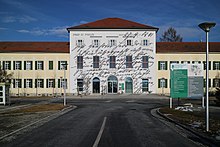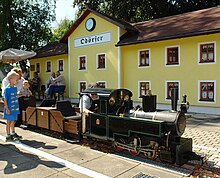LKH Graz II location south
The southern location of the Graz II regional hospital is a special public hospital in the Association of the Steiermärkische Krankenanstaltengesellschaft mbH (KAGes) in Graz . It is located on Wagner-Jauregg-Platz, which is named after the Austrian psychiatrist and Nobel Prize winner Julius Wagner-Jauregg, who temporarily worked at the University of Graz . Since 2019 it has been part of the “LKH Graz II” hospital association.
People with psychological, psychosomatic and neurological diseases from all over Styria and southern Burgenland are treated on an outpatient and inpatient basis, for whom around 780 beds are available.
history
The hospital, originally designed for 460 patients, survived two world wars and still in existence today, has since been expanded with several additions and the inclusion of several branches, is at the beginning of the 21st century a large hospital complex with several specialist areas (departments).
The Feldhof
In 1839 the state authority of the Crown Land of Styria decided to encourage the construction of a so-called “insane asylum” in Graz at the Austrian Court Chancellery in Vienna. This was to serve as a replacement for an existing madhouse for the mentally ill, which was built in 1788 with the support of Emperor Joseph II at the same time as the General Hospital in Graz in Paulustorgasse in the abolished Capuchin monastery . Planning started in 1840, and in 1863 it was decided to build a state insane asylum for Styria in line with the state of medical science at the time . A suitable location was found through the subsequent purchase of the Feldhof , an estate next to Straßgang near Graz with farm buildings and extensive agricultural areas.
The institution building was planned in 1868 as a square with a side length of 200 meters. Behind it there are still farm buildings with a water tower exactly on the axis of symmetry . The foundation stone was laid in 1870. Despite its size, the new state lunatic asylum was handed over to its intended purpose on December 26, 1872, the first director of which was the professor of the University of Graz , Johann Nepomuk Czermak . His brother Joseph Czermak , who was already building the institution in Brno , was involved in the conception of the institution. In May 1873, the psychiatrist Richard von Krafft-Ebing , who had previously worked in Strasbourg, was given the management of the institution. On May 22, 1874, the psychiatric clinic at Feldhof went into operation and Baron von Krafft-Ebing took up the teaching post of psychiatry as primary professor at the University of Graz. In October 1880 he gave up his position as director of the state mental institution to concentrate on teaching and research - in 1885 he was appointed full professor. His successor was Julius Wagner-Jauregg (1857–1940).
time of the nationalsocialism
Under the medical director Oskar Begusch and his successor Ernst Sorger , around 1500 patients were brought to the Hartheim Nazi killing center . Rudolf Lonauer writes of "residues" that he still had in the Niedernhart intermediate institution in Linz, and Begusch of "excess cover" that he wanted to get rid of by means of rail transport. Even Heinrich Wolfer was from 1938 to 1940 there intern.
According to the research of the historian Thomas Oelschläger, there was a “ children's department ” in Feldhof .
The specialist Rainer Danzinger reports: “In some cases they were simply left to die from malnutrition, with the window open with wet clothes. This can be seen from the medical histories, how the children play less and less, become more and more quiet, and then suddenly they are dead."
Naming
The Provincial Lunatic Asylum on Feldhof was renamed the provincial mental hospital for the mentally ill on Feldhof, then the country Special Hospital (LSKH) , then state psychiatric hospital (LNKH) , then - in November 1999, led by Rainer Danzingers - in Landesnervenklinik Sigmund Freud (LSF) . This was intended to honor the revolutionary changed perspectives and treatment approaches for the mentally ill , founded by Sigmund Freud at the turn of the 20th century. At the beginning of 2015 there was a name change due to the merger of the LKH Graz-West and the LSF Graz . The association of both hospitals was called LKH Graz Süd-West , whereby the LSF Graz became the South location and the LKH Graz-West became the West location . At the beginning of 2019, the regional hospitals LKH Graz Süd-West and LKH Hörgas-Enzenbach were merged to form LKH Graz II.
The old nickname Puntigam is still known to the local population on the left , which refers to the local position to the west of the center of Puntigam . In fact, even after the establishment of the independent Puntigam district, the hospital is still in Straßgang . The term Feldhof is also still used colloquially.
Facility
organization
The legal entity of the LKH Graz II location south is the Steiermärkische Krankenanstaltengesellschaft mbH in Graz. The collegial management (medical care administration) of the clinic is formed by a medical directorate, a nursing directorate and an operations directorate.
Medical focus
The focus of the hospital is the treatment of diseases of the central nervous system as well as in the psychological area. In addition to conventional psychiatry, there are also special areas, such as a department for the treatment of addictive disorders as well as gerontopsychiatry (mental illness in older people) and the neuropsychiatric department for children and adolescents. The Department of Neurology specializes, among other things, in the treatment of strokes. There are also some special facilities such as the common departments for sleep medicine, manual medicine , a conservative area and a counseling center for psychological and social issues.
The three adult psychiatric departments, in which about half of the patients are treated, are assigned to the three large regions of Eastern Styria, Western Styria and Upper Styria.
Institutional church
literature
- Norbert Weiss: In the sign of Panther & Schlange , The story for the anniversary of the Styrian state hospitals, KAGesVerlag, Graz 2006, pp. 38-100, ISBN 3-9502281-0-1
- Norbert Weiss: The Graz University Clinic , An Anniversary Story in Hundred Images, KAGesVerlag, Graz 2013, p. 55, ISBN 978-3-9502281-5-1 .
Trivia
In the large park of the institution, the garden railway of the Graz Steam Railway Club was built between 2004 and 2007 to allow steam locomotives to sit on 127 and 184 mm gauge. It is open to the public on many Saturdays during the summer months.
See also
Web links
- Website of the southern location of the LKH Graz II
- http://www.carlos-watzka.at/dokumente/Watzka_Die_Landesirrenanstalt_Feldhof_bei_Graz_und_ihre_Patienten.pdf
Individual evidence
- ^ Elisabeth Bundschuh , website regiowiki.at, accessed on January 16, 2015
- ↑ Online magazine for Styria KORSO estate of Ernst Arlt: Letter documents between Rudolf Lonauer and Oskar Begusch
- ↑ Online presence of the State Neurological Clinic Sigmund Freud Memorial for the victims of euthanasia
- ↑ a b Children as "euthanasia" victims in the former Feldhof. In: steiermark.orf.at. November 4, 2011, accessed November 2, 2018 .
- ↑ Four hospitals become two ( memento of the original from January 2, 2015 in the Internet Archive ) Info: The archive link was inserted automatically and has not yet been checked. Please check the original and archive link according to the instructions and then remove this notice. , Homepage of the KAGes from January 1, 2015
- ↑ Puntigam links on Ostarrichi.org
- ↑ Puntigam ( Memento of the original from March 9, 2016 in the Internet Archive ) Info: The archive link was inserted automatically and has not yet been checked. Please check the original and archive link according to the instructions and then remove this notice. , Total Styria: From A to Z
- ↑ Garden Railway
Coordinates: 47 ° 2 ′ 14 " N , 15 ° 24 ′ 59" E



